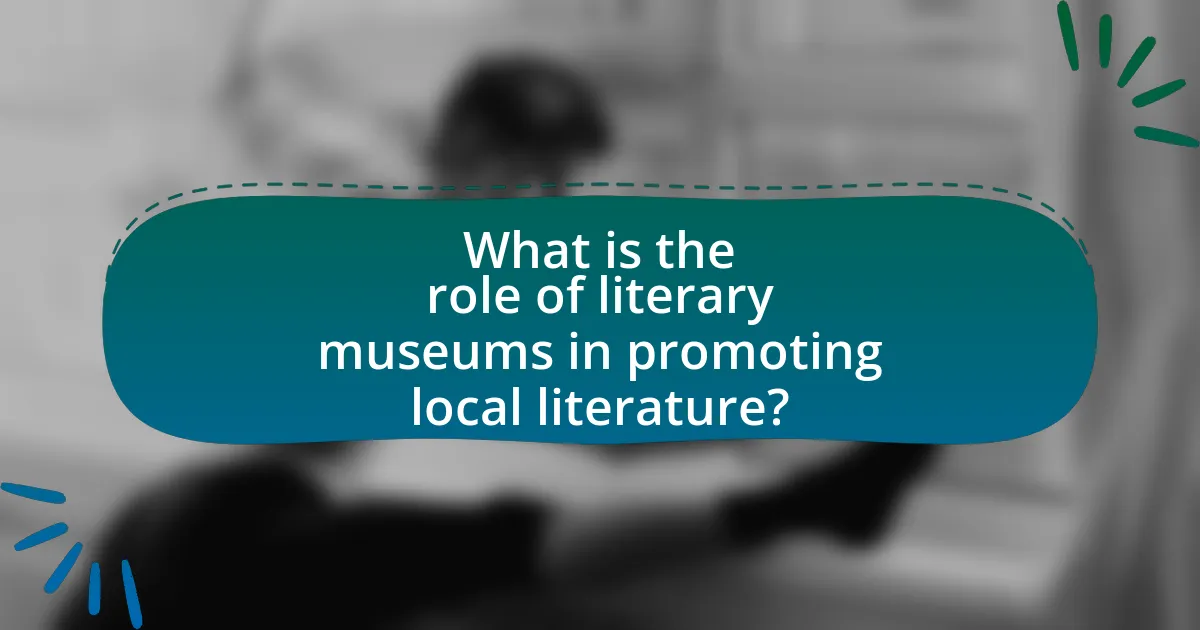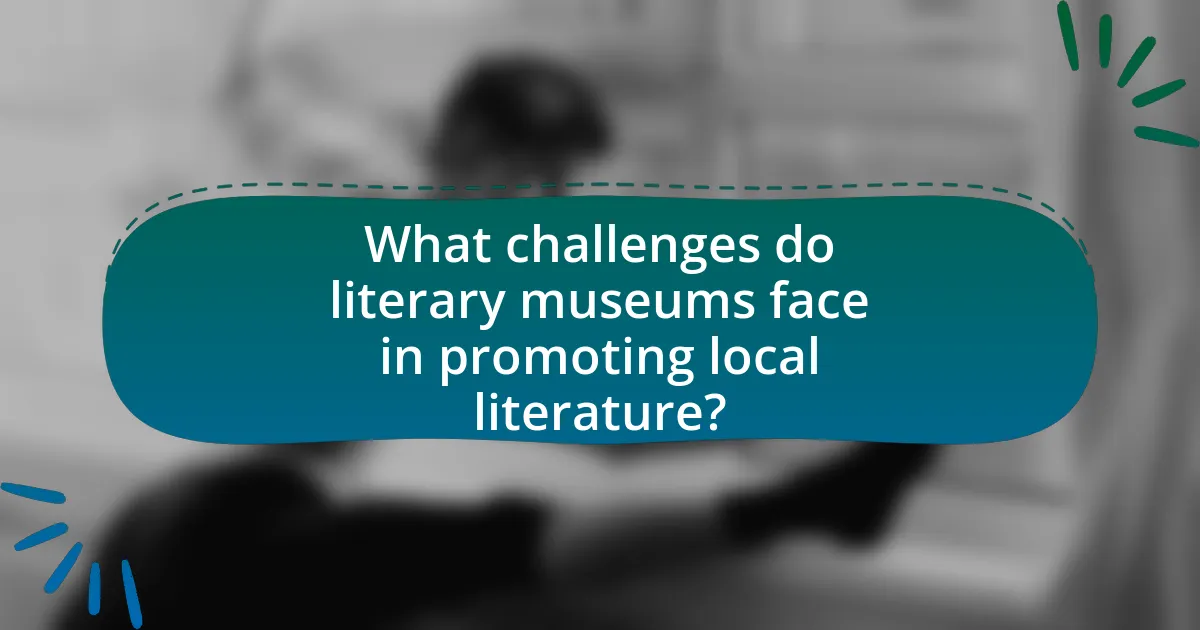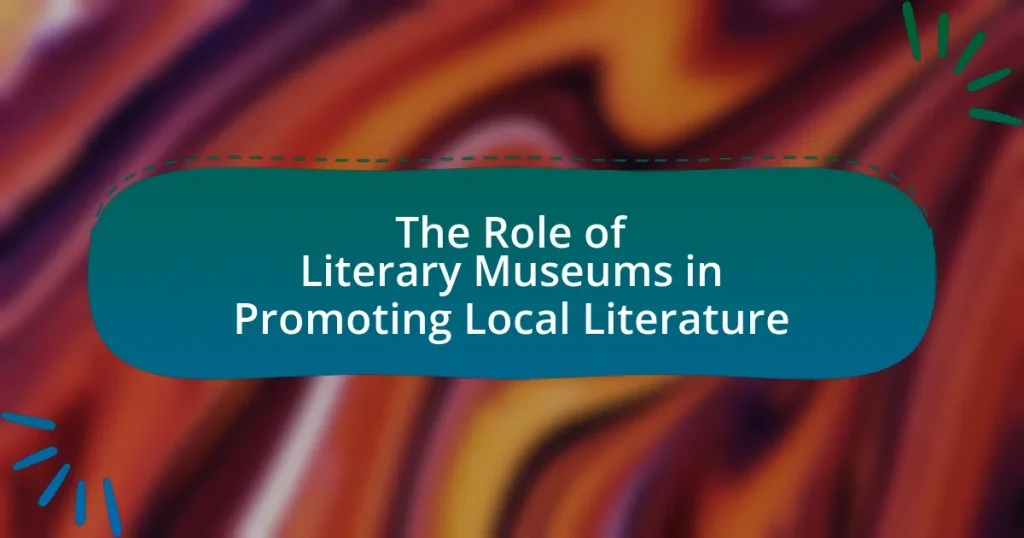Literary museums serve a vital function in promoting local literature by preserving the works of regional authors and enhancing cultural heritage. They provide platforms for exhibitions, readings, and educational programs that engage the community and foster appreciation for local narratives. By showcasing artifacts such as manuscripts and personal belongings of authors, these institutions not only preserve literary heritage but also support emerging writers and facilitate connections between authors and the community. Additionally, literary museums play a significant role in attracting tourism, thereby contributing to the local economy and cultural landscape. The article explores the various ways literary museums engage with the community, the challenges they face, and the strategies they can employ to enhance their visibility and relevance in promoting local literature.

What is the role of literary museums in promoting local literature?
Literary museums play a crucial role in promoting local literature by preserving and showcasing the works of regional authors, thereby enhancing cultural heritage. These institutions provide a platform for exhibitions, readings, and educational programs that highlight local literary contributions, fostering community engagement and appreciation for regional narratives. For instance, the Ernest Hemingway Home and Museum in Key West not only preserves Hemingway’s legacy but also promotes local literary culture through events and collaborations with local writers. This active promotion of local literature helps to cultivate a sense of identity and pride within the community, while also attracting tourism and scholarly interest in the region’s literary history.
How do literary museums contribute to the preservation of local literary heritage?
Literary museums contribute to the preservation of local literary heritage by collecting, curating, and exhibiting artifacts related to local authors and literary movements. These institutions safeguard manuscripts, letters, and personal belongings of writers, which serve as primary sources for understanding the cultural and historical context of their works. For example, the Ernest Hemingway Home and Museum in Key West preserves the author’s residence and personal items, providing insights into his life and influences. Additionally, literary museums often host educational programs, workshops, and events that engage the community, fostering appreciation for local literature and encouraging new generations to explore their literary heritage. This active engagement helps ensure that local literary traditions are recognized and valued, thereby contributing to their ongoing preservation.
What types of artifacts and exhibits do literary museums showcase?
Literary museums showcase a variety of artifacts and exhibits that include manuscripts, letters, first editions of books, personal belongings of authors, photographs, and memorabilia related to literary figures. These items serve to illustrate the lives and works of writers, providing context and insight into their contributions to literature. For example, the Ernest Hemingway Home and Museum displays his typewriter and personal letters, which help visitors understand his writing process and personal life. Such artifacts not only preserve literary heritage but also engage the public in the exploration of local literature and its significance.
How do these artifacts reflect the local literary culture?
Artifacts in literary museums reflect local literary culture by showcasing the works, themes, and historical contexts of regional authors. These artifacts, such as manuscripts, letters, and personal items, provide tangible connections to the literary figures who shaped the community’s narrative. For instance, a manuscript by a local author may highlight specific cultural themes or dialects unique to the area, illustrating how the local environment influences literary expression. Additionally, exhibitions often include contextual information that educates visitors about the socio-political climate during the authors’ lifetimes, further embedding the artifacts within the local literary tradition. This interplay between artifacts and local culture fosters a deeper understanding and appreciation of the region’s literary heritage.
Why are literary museums important for local authors and writers?
Literary museums are important for local authors and writers because they provide a platform for showcasing their work and preserving their literary heritage. These institutions often host exhibitions, readings, and events that highlight local literature, thereby increasing visibility for authors and fostering community engagement. For instance, the Ernest Hemingway Home and Museum in Key West not only celebrates Hemingway’s legacy but also supports local writers through workshops and events, creating a vibrant literary community. Additionally, literary museums often collaborate with schools and universities, promoting literacy and encouraging new generations of writers, which further solidifies their role in the local literary ecosystem.
In what ways do literary museums support emerging writers?
Literary museums support emerging writers by providing resources, networking opportunities, and platforms for showcasing their work. These institutions often host workshops, readings, and mentorship programs that connect novice authors with established writers and industry professionals, fostering skill development and professional growth. For example, the American Writers Museum offers programs specifically designed to engage and support new voices in literature, demonstrating a commitment to nurturing talent. Additionally, literary museums frequently curate exhibitions that highlight local authors, giving emerging writers visibility and a chance to reach wider audiences.
How do literary museums facilitate connections between authors and the community?
Literary museums facilitate connections between authors and the community by serving as cultural hubs that promote local literature through exhibitions, events, and educational programs. These museums often host author readings, workshops, and discussions that allow community members to engage directly with writers, fostering a sense of connection and shared experience. For example, the Ernest Hemingway Home and Museum in Key West regularly organizes events that celebrate Hemingway’s work while inviting local authors to participate, thereby bridging the gap between historical literary figures and contemporary writers. This interaction not only enhances community appreciation for literature but also encourages local authors to gain visibility and support from their audience.
What impact do literary museums have on local tourism?
Literary museums significantly enhance local tourism by attracting visitors interested in literature and cultural heritage. These museums serve as focal points for literary enthusiasts, showcasing the works and lives of local authors, which can lead to increased foot traffic in the area. For instance, the Ernest Hemingway Home and Museum in Key West draws thousands of tourists annually, contributing to the local economy through spending on accommodations, dining, and other attractions. Additionally, literary festivals and events hosted by these museums further stimulate tourism by creating unique experiences that engage visitors and promote local culture.
How do literary museums attract visitors to local literature?
Literary museums attract visitors to local literature by showcasing the works and lives of local authors through curated exhibits, interactive displays, and educational programs. These museums often feature original manuscripts, personal artifacts, and multimedia presentations that highlight the significance of local literature in cultural history. For example, the Ernest Hemingway Home and Museum in Key West offers guided tours that delve into Hemingway’s connection to the area, enhancing visitor engagement with his literary contributions. Additionally, literary museums frequently host events such as readings, workshops, and lectures that foster community involvement and promote local literary talent, thereby increasing foot traffic and interest in regional literature.
What role do literary festivals play in enhancing museum visibility?
Literary festivals significantly enhance museum visibility by attracting diverse audiences and fostering community engagement. These events often feature discussions, readings, and workshops that highlight local literature and its connection to the museum’s collections, thereby increasing foot traffic and interest in the museum’s offerings. For instance, the Edinburgh International Book Festival collaborates with local museums to create programs that showcase literary heritage, resulting in a measurable increase in visitor numbers and public awareness of the museums involved. This synergy not only promotes the museums but also enriches the cultural landscape by linking literature with visual arts and history.

How do literary museums engage with the community?
Literary museums engage with the community through various programs and initiatives that promote local literature and foster cultural appreciation. These museums often host author readings, workshops, and educational programs that invite community members to participate actively in literary discussions and creative writing. For instance, many literary museums collaborate with local schools to provide students with access to literary resources and experiences, enhancing their understanding of local authors and literary heritage. Additionally, exhibitions featuring local writers and their works serve to highlight the community’s literary contributions, creating a sense of pride and connection among residents. This engagement not only enriches the cultural landscape but also strengthens the relationship between the museum and the community it serves.
What programs do literary museums offer to promote local literature?
Literary museums offer various programs to promote local literature, including author readings, workshops, and exhibitions. These programs engage the community by showcasing local authors and their works, providing a platform for discussions and interactions between writers and readers. For instance, many literary museums host annual literary festivals that feature local writers, allowing them to present their work and connect with audiences. Additionally, educational programs such as writing workshops and school outreach initiatives help foster a love for literature among younger generations, ensuring the continuation of local literary traditions. These efforts are supported by statistics indicating that literary museums significantly increase public interest in local literature, as evidenced by increased attendance and participation in literary events.
How do workshops and readings foster community involvement?
Workshops and readings foster community involvement by providing interactive platforms for individuals to engage with literature and each other. These events encourage participation, allowing community members to share their thoughts, experiences, and creativity, which strengthens social bonds. Research indicates that community-based literary programs can enhance civic engagement, as seen in studies conducted by the National Endowment for the Arts, which found that participation in literary activities correlates with increased community cohesion and collaboration.
What partnerships do literary museums form with local schools and libraries?
Literary museums form partnerships with local schools and libraries to enhance literary education and community engagement. These collaborations often include organizing workshops, author talks, and reading programs that promote local authors and literature. For instance, literary museums may provide resources such as curated exhibits or educational materials that align with school curricula, fostering a deeper understanding of literary heritage among students. Additionally, partnerships with libraries can facilitate joint events, such as book clubs or literary festivals, which encourage community participation and appreciation for local literature. These initiatives not only support educational objectives but also strengthen the cultural fabric of the community by connecting students and residents with their literary history.
How do literary museums utilize technology to reach a broader audience?
Literary museums utilize technology by implementing digital platforms, virtual tours, and interactive exhibits to engage a wider audience. For instance, many museums have developed mobile applications that provide access to multimedia content, allowing users to explore literary works and author biographies remotely. Additionally, virtual reality experiences enable visitors to immerse themselves in historical literary settings, enhancing educational outreach. According to a 2021 survey by the American Alliance of Museums, 70% of museums reported increased visitor engagement through digital initiatives, demonstrating the effectiveness of technology in broadening audience reach.
What digital initiatives are being implemented by literary museums?
Literary museums are implementing various digital initiatives to enhance engagement and accessibility. These initiatives include virtual exhibitions that allow global audiences to explore literary artifacts and interactive online platforms that facilitate discussions and workshops. For instance, the British Library offers digital collections and online events that showcase local literature, while the American Writers Museum provides virtual tours and educational resources. These efforts not only broaden the reach of literary museums but also promote local literature by making it accessible to a wider audience.
How do virtual tours enhance accessibility to local literature?
Virtual tours enhance accessibility to local literature by allowing individuals to explore literary museums and related sites remotely, breaking geographical barriers. This digital approach enables users from diverse locations to engage with local literary works, authors, and historical contexts without the need for physical travel. For instance, a study by the American Alliance of Museums found that virtual tours can increase visitor engagement by up to 50%, demonstrating their effectiveness in reaching wider audiences. Additionally, these tours often include multimedia elements such as audio readings and interactive exhibits, which further enrich the experience and make literature more approachable for various demographics, including those with mobility challenges.

What challenges do literary museums face in promoting local literature?
Literary museums face several challenges in promoting local literature, primarily limited funding, lack of public awareness, and competition from digital media. Limited funding restricts the ability of these museums to host events, acquire new exhibits, or engage in marketing efforts that could attract visitors. For instance, a report from the American Alliance of Museums indicates that many cultural institutions operate on tight budgets, which hampers their outreach capabilities. Additionally, a lack of public awareness about the significance of local literature can lead to low visitor turnout, as many individuals may not recognize the value of local authors and their contributions. Lastly, competition from digital media, including e-books and online literary platforms, diverts attention away from physical museums, making it difficult for these institutions to engage audiences effectively.
How do funding and resources affect the operations of literary museums?
Funding and resources significantly impact the operations of literary museums by determining their ability to curate exhibitions, maintain facilities, and engage in educational programming. Adequate funding allows literary museums to acquire rare manuscripts, host author events, and develop outreach initiatives that promote local literature. For instance, the American Alliance of Museums reports that museums with stable funding can increase visitor engagement by up to 30%, enhancing their role in community education and cultural preservation. Conversely, limited resources can lead to reduced staffing, fewer programs, and diminished public access, ultimately hindering the museum’s mission to promote local literary heritage.
What strategies can literary museums employ to secure funding?
Literary museums can employ diverse strategies to secure funding, including grant applications, partnerships with educational institutions, and community fundraising initiatives. Grant applications to government bodies and private foundations can provide substantial financial support, as evidenced by the National Endowment for the Arts, which awarded over $27 million in grants in 2020 to arts organizations, including museums. Collaborating with universities can lead to joint programs that attract funding and enhance educational outreach, while community fundraising initiatives, such as literary festivals or membership drives, can engage local supporters and generate revenue. These strategies collectively enhance the financial sustainability of literary museums, enabling them to promote local literature effectively.
How do budget constraints impact programming and outreach?
Budget constraints significantly limit the scope and effectiveness of programming and outreach initiatives in literary museums. When funding is restricted, museums may reduce the number of events, limit the diversity of programming, and cut back on marketing efforts, which directly affects audience engagement and community involvement. For instance, a study by the American Alliance of Museums found that 60% of museums reported that budget limitations hindered their ability to offer educational programs and outreach activities. This reduction in programming not only diminishes the museum’s role in promoting local literature but also impacts its ability to attract visitors and foster community connections.
What role does public perception play in the success of literary museums?
Public perception significantly influences the success of literary museums by shaping visitor interest and engagement. Positive public perception can lead to increased attendance, as individuals are more likely to visit museums that are viewed favorably within the community. For instance, a survey conducted by the American Alliance of Museums found that 70% of respondents are more inclined to visit a museum that is perceived as relevant and valuable to local culture. Furthermore, literary museums that actively engage with their communities through events, educational programs, and social media can enhance their reputation, thereby attracting a broader audience. This connection between public perception and visitor numbers underscores the importance of community involvement and effective communication in ensuring the success of literary museums.
How can literary museums improve their visibility and relevance in the community?
Literary museums can improve their visibility and relevance in the community by actively engaging with local audiences through events, partnerships, and educational programs. For instance, hosting author readings, workshops, and community discussions can attract diverse groups and foster a sense of ownership among residents. Collaborating with local schools and universities to integrate literary history into curricula can also enhance educational outreach, making the museum a vital resource for students and educators. Furthermore, utilizing social media platforms to share stories, artifacts, and upcoming events can significantly increase online engagement, reaching a broader audience. Research indicates that museums that implement community-focused initiatives see a 30% increase in visitor numbers, demonstrating the effectiveness of these strategies in enhancing visibility and relevance.
What marketing strategies can be effective for literary museums?
Effective marketing strategies for literary museums include targeted social media campaigns, partnerships with local schools and universities, and hosting literary events. Targeted social media campaigns can engage specific demographics interested in literature, as evidenced by the success of museums that utilize platforms like Instagram and Facebook to showcase exhibits and events, increasing visitor engagement by up to 30%. Partnerships with educational institutions can enhance outreach, as studies show that collaborative programs with schools can boost attendance by attracting student groups. Additionally, hosting literary events such as author readings, workshops, and book fairs can draw in diverse audiences, with events reported to increase foot traffic by 50% during peak times. These strategies collectively promote local literature and enhance the visibility of literary museums.
What best practices can literary museums adopt to enhance their role in promoting local literature?
Literary museums can enhance their role in promoting local literature by actively engaging with the community through events, exhibitions, and educational programs. These institutions should host author readings, workshops, and literary festivals that spotlight local writers and their works, fostering a connection between the authors and the audience. Additionally, collaborating with local schools and universities to integrate local literature into their curricula can further promote awareness and appreciation.
Research indicates that community involvement significantly increases the visibility of local literature; for instance, a study by the American Alliance of Museums found that museums that engage with local authors and host community events see a 30% increase in visitor engagement. By implementing these practices, literary museums can effectively serve as cultural hubs that celebrate and promote the richness of local literary heritage.
How can collaboration with local authors improve museum programs?
Collaboration with local authors can enhance museum programs by integrating authentic narratives and cultural insights that resonate with the community. This partnership allows museums to curate exhibitions and events that reflect local literary heritage, fostering a deeper connection between visitors and the region’s history. For instance, when local authors participate in storytelling sessions or workshops, they provide firsthand accounts and interpretations of local literature, enriching the educational experience. Research indicates that museums that engage with local creatives see increased visitor engagement and satisfaction, as these programs often attract diverse audiences and encourage community participation.
What innovative approaches can be taken to engage younger audiences?
Innovative approaches to engage younger audiences include utilizing interactive technology, such as augmented reality (AR) and virtual reality (VR), to create immersive experiences that bring local literature to life. For instance, literary museums can develop AR applications that allow visitors to interact with characters from local stories or explore historical contexts through their smartphones. Research indicates that 70% of younger audiences prefer experiences that incorporate technology, highlighting the effectiveness of this method in attracting their interest. Additionally, hosting events like poetry slams, writing workshops, and social media campaigns can foster community involvement and encourage younger individuals to connect with local literature in a dynamic way.


